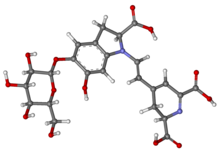Betanin

| |

| |
| Names | |
|---|---|
| IUPAC name
(2S)-1-{2-[(2S)-2,6-dicarboxy-2,3-dihydropyridin-4(1H)-ylidene]ethylidene}-5-(β-d-glucopyranosyloxy)-6-hydroxy-2,3-dihydro-1H-indol-1-ium-2-carboxylate
| |
| Identifiers | |
3D model (JSmol)
|
|
| ChEBI | |
| ChEMBL | |
| ChemSpider | |
| ECHA InfoCard | 100.028.753 |
| E number | E162 (colours) |
| KEGG | |
PubChem CID
|
|
| UNII | |
CompTox Dashboard (EPA)
|
|
| |
| |
| Properties | |
| C24H26N2O13 | |
| Molar mass | 550.47 g/mol |
Except where otherwise noted, data are given for materials in their standard state (at 25 °C [77 °F], 100 kPa).
| |
Betanin, or beetroot red, is a red glycosidic food dye obtained from beets; its aglycone, obtained by hydrolyzing the glucose molecule, is betanidin. As a food additive, its E number is E162.[1] As a food additive, betanin has no safety concerns.[1]
The color of betanin depends on pH; between pH four and five, it is bright bluish-red, becoming blue-violet as the pH increases. Once the pH reaches alkaline levels, betanin degrades by hydrolysis, resulting in a yellow-brown color.[citation needed]
Betanin is a betalain pigment, together with isobetanin and other betacyanins.[2]
Sources[edit]
Betanin is usually obtained from the extract of beet juice; the concentration of betanin in red beet can reach 300–600 mg/kg. Other dietary sources of betanin and other betalains include the Opuntia cactus, Swiss chard, and the leaves of some strains of amaranth.[citation needed]
Uses[edit]
The most common uses of betanins are in coloring ice cream and powdered soft drink beverages; other uses are in some sugar confectionery, e.g. fondants, sugar strands, sugar coatings, and fruit or cream fillings. In hot processed candies, it can be used if added at the final part of the processing. Betanin is also used in soups as well as tomato and bacon products. Betanin has "not been implicated as causing clinical food allergy when used as a coloring agent".[3]
Betanin has also shown to have antimicrobial activity and can be used as a natural antimicrobial agent in food preservation.[4]
Degradation and stability[edit]
Betanin degrades when subjected to light, heat, and oxygen; therefore, it is used in frozen products, products with short shelf life, or products sold in dry state. Betanin can survive pasteurization when in products with high sugar content. Its sensitivity to oxygen is highest in products with a high water content and/or containing metal cations (e.g. iron and copper); antioxidants like ascorbic acid and sequestrants can slow this process down, together with suitable packaging. In dry form betanin is stable in the presence of oxygen.[5]
Safety[edit]
Use of betanin and other betacyanins as food coloring has a long history in Europe.[1] A scientific panel for the European Food Safety Authority found that acute or chronic toxicity and carcinogenicity studies were too limited to determine that these food colorants were unsafe.[1] The panel also concluded that the available toxicological database could not provide data to assign an acceptable daily intake level for beetroot red.[1]
See also[edit]
References[edit]
- ^ a b c d e EFSA Panel on Food Additives and Nutrient Sources added to Food (9 December 2015). "Scientific Opinion on the re-evaluation of beetroot red (E 162) as a food additive". EFSA Journal. 13 (12): 4318. doi:10.2903/j.efsa.2015.4318.
- ^ Polturak G, Aharoni A (January 2018). ""La Vie en Rose": Biosynthesis, Sources, and Applications of Betalain Pigments". Molecular Plant. 11 (1): 7–22. doi:10.1016/j.molp.2017.10.008. PMID 29081360.
- ^ Dean D. Metcalfe, Hugh A. Sampson, Ronald A. Simon: Food Allergy: Adverse Reactions to Foods and Food Additives. 4th Ed., Blackwell Publishing, 2009, ISBN 978-1-4051-5129-0, p. 416.
- ^ Manohar, Cynthya M.; Kundgar, Saurabh D.; Doble, Mukesh (1 July 2017). "Betanin immobilized LDPE as antimicrobial food wrapper". LWT. 80: 131–135. doi:10.1016/j.lwt.2016.07.020.
- ^ Herbach, Kirsten M.; Stintzing, Florian C.; Carle, Reinhold (May 2006). "Betalain Stability and Degradation?Structural and Chromatic Aspects". Journal of Food Science. 71 (4): R41–R50. doi:10.1111/j.1750-3841.2006.00022.x. ISSN 0022-1147.
Further reading[edit]
- Harmer, R.A. (January 1980). "Occurrence, chemistry and application of betanin". Food Chemistry. 5 (1): 81–90. doi:10.1016/0308-8146(80)90066-7.
